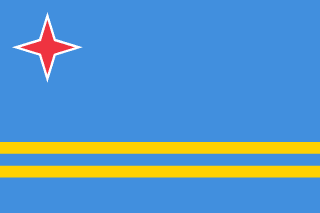Aruba - Geography

Here, let us take a look at the Geography of Aruba. A flat, riverless island known for its white sand beaches; its tropical climate is moderated by constant trade winds from the Atlantic Ocean; the temperature is almost constant at about 27 degrees Celsius (81 degrees Fahrenheit). Mother's mean age at first birth is (), whereas, the Maternal mortality ratio is
Geographical data of Aruba
| Location | Caribbean, island in the Caribbean Sea, north of Venezuela |
|---|---|
| Geographic coordinates | 12 30 N, 69 58 W |
| Map references | Central America and the Caribbean |
| Tarrain | flat with a few hills; scant vegetation |
| Natural Resources | NEGL; white sandy beaches foster tourism |
| Natural Hazards | hurricanes; lies outside the Caribbean hurricane belt and is rarely threatened |
| Irrigated Land | NA |
| Major rivers (by length in km) | |
| Major aquifers | |
| Land Boundaries | 0 km |
| Border Countries | |
| Coastline | 68.5 km |
| Climate | tropical marine; little seasonal temperature variation |
| Area | |
| Total Area | |
| Land Area | 180 sq km |
| Water Area | 0 sq km |
| comparative Area | slightly larger than Washington, D.C. |
| Maritime Claims | |
| Territorial sea | 12 nm |
| Exclusive economic zone | 200 nm |
| Elevations | |
| Highest point | Ceru Jamanota 188 m |
| Lowest point | Caribbean Sea 0 m |
| Land Use | |
| Agricultural land | 11.1% (2022 est.) |
| Agricultural land: arable land | arable land: 11.1% (2022 est.) |
| Agricultural land: permanent crops | permanent crops: 0% (2022 est.) |
| Agricultural land: permanent pasture | permanent pasture: 0% (2022 est.) |
| Forest | 2.3% (2022 est.) |
| Other | 86.6% (2022 est.) |
Population Distribution
Most residents live in or around Oranjestad and San Nicolaas; most settlements tend to be located on the less mountainous western side of the island
People and Society
In Aruba, the different Ethnic groups are such that we have: Dutch 78.7%, Colombian 6.6%, Venezuelan 5.5%, Dominican 2.8%, Haitian 1.3%, other 5.1% (2020 est.)
| Population | |
|---|---|
| Pop growth rate | 1.08% (2024 est.) |
| Birth rate | 11.6 births/1,000 population (2024 est.) |
| Death rate | 8.8 deaths/1,000 population (2024 est.) |
| Health expenditure | |
| Physicians Density | |
| Hospital bed Density | |
| Total fertility rate | 1.82 children born/woman (2024 est.) |
| Gross reproduction rate | 0.9 (2024 est.) |
| Contraceptive prevalence rate | |
| Est married women (ages 15-49) | 42.1% (2023 est.) |
| Literacy | |
| Education expenditures | |
| Net Migration rate | 8 migrant(s)/1,000 population (2024 est.) |
| Nationality | Aruban; Dutch | Aruban(s) |
| Languages | Papiamento (official) (a creole language that mixes Portuguese, Spanish, Dutch, English, French, African languages, and Arawak) 69.4%, Spanish 13.7%, English (widely spoken) 7.1%, Dutch (official) 6.1%, Chinese 1.5%, other 1.7%, unspecified 0.4% (2010 est.) |
| Religions | Roman Catholic 75.3%, Protestant 4.9% (includes Methodist 0.9%, Adventist 0.9%, Anglican 0.4%, other Protestant 2.7%), Jehovah's Witness 1.7%, other 12%, none 5.5%, unspecified 0.5% (2010 est.) |
| Age Structure | |
| 0-14 years | 17.2% (male 10,815/female 10,747) |
| 15-64 years | 65.7% (male 39,621/female 42,487) |
| 65 years and over | 17.1% (2024 est.) (male 8,665/female 12,728) |
| Dependency Ratios | |
| Total dependency ratio | 52.3 (2024 est.) |
| Youth dependency ratio | 26.3 (2024 est.) |
| Elderly dependency ratio | 26.1 (2024 est.) |
| Potential support ratio | 3.8 (2024 est.) |
| Median Age | |
| Total | 40.9 years (2024 est.) |
| Male | 39.3 years |
| Female | 42.4 years |
| Urbanization | |
| Urban population | 44.3% of total population (2023) |
| Rate of urbanization | 0.77% annual rate of change (2020-25 est.) |
| Major urban areas (Pop) | 30,000 ORANJESTAD (capital) (2018). |
| Sex Ratio | |
| At birth | 1.02 male(s)/female |
| 0-14 years | 1.01 male(s)/female |
| 15-64 years | 0.93 male(s)/female |
| 65 years and over | 0.68 male(s)/female |
| Total population | 0.9 male(s)/female (2024 est.) |
| Infant Motality | |
| Total | 11.5 deaths/1,000 live births (2024 est.) |
| Male | 15.6 deaths/1,000 live births |
| Female | 7.3 deaths/1,000 live births |
| Life Expectancy at birth | |
| Total population | 78.5 years (2024 est.) |
| Male | 75.4 years |
| Female | 81.6 years |
| Sanitation facility acess | |
| Improved: total | total: 98.8% of population (2022 est.) |
| Unimproved: total | total: 1.2% of population (2022 est.) |
Demographic profile
All Important Facts about Aruba
Want to know more about Aruba? Check all different factbooks for Aruba below.









